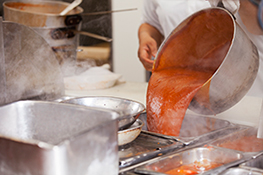
Navigating the Hazards: A Guide to Safe Food Heating Practices
Introduction:
In the fast-paced rhythm of modern life, the convenience of quickly heating food has become a common practice. However, beneath the surface of this seemingly innocuous task lies a realm of potential dangers. From uneven heating to harmful chemicals, the process of warming up our meals requires a mindful approach. In this blog, we’ll explore the risks associated with heating food and delve into effective ways to prevent mishaps and ensure that our culinary convenience doesn’t compromise our health.
1. Microwave Marvels and the Pitfalls:
Microwaves have revolutionized the way we heat our food, offering unparalleled speed and efficiency. However, their convenience comes with its own set of hazards. Uneven heating is a common issue, as microwaves can create hot spots while leaving other areas cool. This can lead to undercooked or overheated food, posing a risk of foodborne illnesses.
Prevention: To ensure even heating, it’s crucial to stir or rotate food midway through the microwaving process. Using microwave-safe containers and covering food with microwave-safe lids or wraps helps trap heat and promotes uniform cooking.
2. The Perils of Plastic:
The widespread use of plastic containers for reheating food has raised concerns about the release of harmful chemicals into our meals. Plastic containers may contain substances like bisphenol A (BPA) or phthalates, which can leach into food when exposed to heat. These chemicals are associated with adverse health effects, including endocrine disruption.
Prevention: Opt for microwave-safe glass or ceramic containers instead of plastic. Check for labels indicating “microwave-safe” or “BPA-free” to ensure the chosen containers are safe for heating. Additionally, avoid using scratched or damaged containers, as they may release harmful chemicals.
3. Aluminum Foil Follies:
While aluminum foil is a popular choice for wrapping and covering food during heating, it can pose risks when used incorrectly. When placed too close to the oven walls or in large quantities, aluminum foil can lead to fire hazards. Moreover, using foil to cook acidic or spicy foods may result in the transfer of aluminum into the meal, which has been linked to health concerns.
Prevention: Keep a safe distance between aluminum foil and oven walls, and avoid using excessive amounts. When in doubt, use alternatives like parchment paper or oven-safe glassware. Reserve aluminum foil for wrapping or covering non-acidic and non-spicy foods.
4. Radiation Worries:
Radiation from microwaves and other heating sources can alter the nutritional content of food. While the impact may be minimal, repeated exposure to high levels of radiation can lead to nutrient degradation. Overcooking and excessive microwaving may result in a loss of vitamins and minerals, diminishing the nutritional value of your meals.
Prevention: Opt for gentler heating methods whenever possible, such as steaming or using a stovetop. Be mindful of cooking times and avoid prolonged exposure to high temperatures. This ensures that your food retains its nutritional integrity while still being safely heated.
5. Leftovers Lethargy:
Reheating leftovers is a common practice, but it comes with its own set of challenges. Improper storage and reheating can lead to the growth of harmful bacteria, increasing the risk of foodborne illnesses. Inadequate refrigeration or leaving food at room temperature for extended periods can create an environment conducive to bacterial proliferation.
Prevention: Store leftovers promptly in airtight containers and refrigerate them at or below 40°F (4°C). When reheating, ensure that the entire dish reaches an internal temperature of at least 165°F (74°C) to eliminate bacteria. Avoid reheating the same batch multiple times to minimize the risk of contamination.
6. Mindful Monitoring:
Neglecting to monitor the heating process can result in overcooking or, worse, fires. Leaving appliances unattended, whether it’s a stovetop or a microwave, can have serious consequences. Overheating can cause food to catch fire, release harmful fumes, or damage the appliance.
Prevention: Always stay vigilant when heating food. Set timers, use kitchen thermometers to check internal temperatures, and never leave appliances unattended. In the case of stovetop cooking, use a timer, and keep flammable materials away from the heat source.
Conclusion:
While the convenience of heating food is undeniable, it’s crucial to approach this everyday task with caution. From microwaving mishaps to the potential dangers of plastic and aluminum foil, there are various pitfalls that can compromise our well-being. By adopting safe practices, choosing appropriate containers, and being mindful of cooking times, we can navigate these hazards and enjoy the convenience of warm meals without jeopardizing our health. As we prioritize safety in our kitchens, we ensure that the warmth we seek in our food doesn’t come at the cost of hidden dangers.
